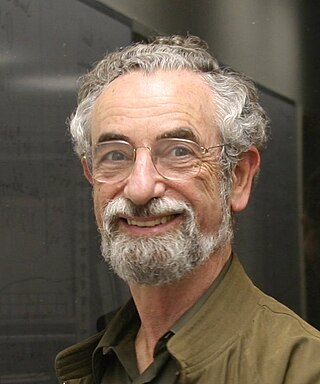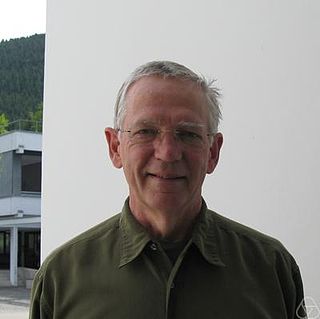
Yang Chen-Ning or Chen-Ning Yang, also known as C. N. Yang or by the English name Frank Yang, is a Chinese theoretical physicist who made significant contributions to statistical mechanics, integrable systems, gauge theory, and both particle physics and condensed matter physics. He and Tsung-Dao Lee received the 1957 Nobel Prize in Physics for their work on parity non-conservation of weak interaction. The two proposed that one of the basic quantum-mechanics laws, the conservation of parity, is violated in the so-called weak nuclear reactions, those nuclear processes that result in the emission of beta or alpha particles. Yang is also well known for his collaboration with Robert Mills in developing non-abelian gauge theory, widely known as the Yang–Mills theory.
The Ising model, named after the physicists Ernst Ising and Wilhelm Lenz, is a mathematical model of ferromagnetism in statistical mechanics. The model consists of discrete variables that represent magnetic dipole moments of atomic "spins" that can be in one of two states. The spins are arranged in a graph, usually a lattice, allowing each spin to interact with its neighbors. Neighboring spins that agree have a lower energy than those that disagree; the system tends to the lowest energy but heat disturbs this tendency, thus creating the possibility of different structural phases. The model allows the identification of phase transitions as a simplified model of reality. The two-dimensional square-lattice Ising model is one of the simplest statistical models to show a phase transition.
In physics, mathematics and statistics, scale invariance is a feature of objects or laws that do not change if scales of length, energy, or other variables, are multiplied by a common factor, and thus represent a universality.

Alexander Markovich Polyakov is a Russian theoretical physicist, formerly at the Landau Institute in Moscow and, since 1989, at Princeton University, where he is the Joseph Henry Professor of Physics Emeritus.
Alexander Grossmann was a French-American physicist of Croatian origin.

Elliott Hershel Lieb is an American mathematical physicist. He is a professor of mathematics and physics at Princeton University. Lieb's works pertain to quantum and classical many-body problem, atomic structure, the stability of matter, functional inequalities, the theory of magnetism, and the Hubbard model.
In mathematics, integrability is a property of certain dynamical systems. While there are several distinct formal definitions, informally speaking, an integrable system is a dynamical system with sufficiently many conserved quantities, or first integrals, that its motion is confined to a submanifold of much smaller dimensionality than that of its phase space.

Craig Arnold Tracy is an American mathematician, known for his contributions to mathematical physics and probability theory.
Tai Tsun Wu is a Chinese-born American physicist and writer well known for his contributions to high-energy nuclear physics and statistical mechanics.

Alexander Borisovich Zamolodchikov is a Russian physicist, known for his contributions to conformal field theory, statistical mechanics, string theory and condensed matter physics.
A spin model is a mathematical model used in physics primarily to explain magnetism. Spin models may either be classical or quantum mechanical in nature. Spin models have been studied in quantum field theory as examples of integrable models. Spin models are also used in quantum information theory and computability theory in theoretical computer science. The theory of spin models is a far reaching and unifying topic that cuts across many fields.

Michael Aizenman is an American-Israeli mathematician and a physicist at Princeton University, working in the fields of mathematical physics, statistical mechanics, functional analysis and probability theory.
Thomas C. Spencer is an American mathematical physicist, known in particular for important contributions to constructive quantum field theory, statistical mechanics, and spectral theory of random operators. He is an emeritus faculty member at the Institute for Advanced Study.
Antti Kupiainen is a Finnish mathematical physicist.

Tetsuji Miwa is a Japanese mathematician, specializing in mathematical physics.
Olaf Lechtenfeld is a German mathematical physicist, academic and researcher. He is a full professor at the Institute of Theoretical Physics at Leibniz University, where he founded the Riemann Center for Geometry and Physics.

Giovanni Felder is a Swiss mathematical physicist and mathematician, working at ETH Zurich. He specializes in algebraic and geometric properties of integrable models of statistical mechanics and quantum field theory.

Krzysztof Gawędzki was a Polish mathematical physicist, a graduate of the University of Warsaw and professor at the École normale supérieure de Lyon. He was primarily known for his research on quantum field theory and statistical physics. In 2022, he shared the Dannie Heineman Prize for Mathematical Physics with Antti Kupiainen.
André LeClair is a Canadian-American physicist and academic. He is a Professor at the Cornell University.









